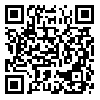Volume 14, Issue 2 (Summer 2007)
J Birjand Univ Med Sci. 2007, 14(2): 9-15 |
Back to browse issues page
Download citation:
BibTeX | RIS | EndNote | Medlars | ProCite | Reference Manager | RefWorks
Send citation to:



BibTeX | RIS | EndNote | Medlars | ProCite | Reference Manager | RefWorks
Send citation to:
Ziyaei M, Azarkar G, Saadatjou S, Namaei M. Study of shigella genera and their drug resistance in dysenteric patients referring to Nehbandan health -care centers and health houses. Journals of Birjand University of Medical Sciences 2007; 14 (2) :9-15
URL: http://journal.bums.ac.ir/article-1-139-en.html
URL: http://journal.bums.ac.ir/article-1-139-en.html
1- Assistant Professor, Department of Social Medicine, Faculty of Medicine, Birjand University of Medical Sciences. Birjand, Iran , npziaee @yahoo.com
2- Physician; Birjand University of Medical Sciences. Birjand, Iran
3- Instructor; Faculty of Nursing and Midwifery, Birjand University of Medical Sciences. Birjand, Iran
4- Assistant Professor, Department of Microbiology, Faculty of Medicine, Birjand University of Medical Sciences. Birjand, Iran
2- Physician; Birjand University of Medical Sciences. Birjand, Iran
3- Instructor; Faculty of Nursing and Midwifery, Birjand University of Medical Sciences. Birjand, Iran
4- Assistant Professor, Department of Microbiology, Faculty of Medicine, Birjand University of Medical Sciences. Birjand, Iran
Abstract: (27396 Views)
Background and Aim: Bloody diarrhea (dysentery) is one of the acute gastrointestinal diseases and Shigellosis is an important cause of it in our country. Variety of its causing agents (Shigella strains) and occurrence of drug resistance have made troubles in selecting of appropriate antibiotics for the treatment of shigellosis. The current study was aimed at identifying different strains of shigella and assessing their drug resistance in the urban and rural regions of Nehbandan.
Materials and Methods: In this quasi experimental study 140 patients presented with acute bloody diarrhea referring to the rural and urban health centers and health houses of Nehbandan were studied. Their stool samples were cultured and underwent antibiogram tests after being carried to a Birjand medical diagnostic laboratory. Cultures were prepared according to WHO standard protocols on Eosin Methylen Blue (EMB) and Shigella - salmonella agar (SS) media. Drug susceptibility was done using disk diffusion method. The obtained data was analyzed by Chi-square and Fisher test, and P<0.05 was considered as the significant level.
Results: 35 (25%) out of 140 patients were positive regarding shigellosis. The most frequent shigella serotypes were shigella Flexneri in 30 cases (85.7%), shigella Boydii in 4 cases (11.4%) and shigella Sonnei in 1 case (2.9%). All shigella strains were sensitive to Ciprofloxacin and Nalidixic acid, but 85.7% to Cefixime. Only 20% of shigella strains were sensitive to Co-trimoxazole.
Conclusion: According to the study, using Nalidixic acid is recommended as the first line of treatment in shigellosis due to low price, few side effects and availability in health centers.
Materials and Methods: In this quasi experimental study 140 patients presented with acute bloody diarrhea referring to the rural and urban health centers and health houses of Nehbandan were studied. Their stool samples were cultured and underwent antibiogram tests after being carried to a Birjand medical diagnostic laboratory. Cultures were prepared according to WHO standard protocols on Eosin Methylen Blue (EMB) and Shigella - salmonella agar (SS) media. Drug susceptibility was done using disk diffusion method. The obtained data was analyzed by Chi-square and Fisher test, and P<0.05 was considered as the significant level.
Results: 35 (25%) out of 140 patients were positive regarding shigellosis. The most frequent shigella serotypes were shigella Flexneri in 30 cases (85.7%), shigella Boydii in 4 cases (11.4%) and shigella Sonnei in 1 case (2.9%). All shigella strains were sensitive to Ciprofloxacin and Nalidixic acid, but 85.7% to Cefixime. Only 20% of shigella strains were sensitive to Co-trimoxazole.
Conclusion: According to the study, using Nalidixic acid is recommended as the first line of treatment in shigellosis due to low price, few side effects and availability in health centers.
Type of Study: Original Article |
Subject:
Microbiology
Received: 2006/09/6 | Accepted: 2016/03/10 | ePublished: 2016/03/10
Received: 2006/09/6 | Accepted: 2016/03/10 | ePublished: 2016/03/10
Send email to the article author
| Rights and permissions | |
 |
This work is licensed under a Creative Commons Attribution-NonCommercial 4.0 International License. |





